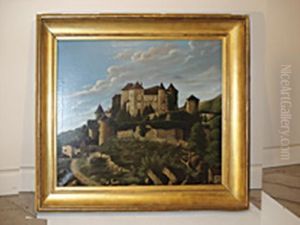Louis Leopold Chambard Paintings
Louis Leopold Chambard was a 19th-century French sculptor known for his work in marble and stone. Born in 1811 in the town of Orgelet in the Jura department of France, Chambard was nurtured in an environment that was undergoing significant cultural and political changes, given the post-revolutionary context of the country.
He showed an early interest in the arts and soon embarked on his journey to develop his skills as a sculptor. Chambard studied under prominent artists of the time and was influenced by the neoclassical style that was prevalent during the early part of the 19th century. This style emphasized clarity, order, and balance, hallmarks that would come to be reflected in Chambard’s own work. He also absorbed elements of Romanticism, which began to gain prominence during his career, adding emotion and drama to his sculptures.
In the 1830s, Chambard moved to Paris, which was then the cultural hub of France and a magnet for artists seeking to establish their careers. There, he immersed himself in the city's vibrant art scene and began to exhibit his work at the Salon, the official art exhibition of the Académie des Beaux-Arts in Paris. Chambard’s sculptures were often characterized by their detailed craftsmanship and the lifelike quality of his figures. His work included both secular and religious subjects, and he received commissions for public monuments as well as private collections.
Despite the prevalence of neoclassicism in his early work, Chambard was not immune to the influences of the evolving artistic movements of the time. As he matured as an artist, his style displayed an increasing fluidity and expressiveness, characteristics of the emerging Romantic style. Chambard's reputation grew, and he became known for his ability to imbue marble and stone with a sense of softness and warmth, a testament to his technical prowess and artistic sensitivity.
Chambard’s career spanned much of the 19th century, a period that saw significant social, political, and artistic changes. Throughout, he continued to produce work that resonated with both critics and the public. Louis Leopold Chambard passed away in 1895, leaving behind a legacy of work that captured the transitional period of French sculpture from neoclassicism to Romanticism. His sculptures remain an integral part of France's artistic heritage, reflecting the cultural milieu of his time and the timeless qualities of human expression.
